Key Points:
- Some of the most common non-venomous snakes in Kentucky are: eastern garter snake, gray rat snake, and ring-necked snake.
- Out of the five species of true water snakes in the state, four are found in Western Kentucky.
- There are four venomous snakes in Kentucky: the copperhead snake, timber rattlesnake, northern cottonmouth, and western pygmy rattlesnake.
Kentucky has a lot of wildlife, including a lot of snakes that you should watch out for when you’re taking advantage of the great hunting, fishing, and hiking that’s available in the state. Even though you may come across any of the 34 types of snakes in Kentucky when you’re enjoying outdoor activities there are only four venomous (poisonous) types of snakes in Kentucky. So your chances of being seriously injured by a snake in Kentucky are pretty low. If you pay attention to your surroundings and are familiar with the types of snakes in Kentucky, you’ll be able to enjoy the outdoors with confidence!
Common Snakes Found in Kentucky
The good news for anyone in Kentucky that likes to hunt, fish, hike, camp, or just spend time outdoors in nature is that most of the snakes in Kentucky are not venomous. There are only four types of venomous snakes in Kentucky. If you do see a snake when you’re outdoors you should always be careful of them, but in most cases snakes won’t attack or bite you. Generally snakes only bite or attack if they feel cornered or if you surprise them. Some of the most common nonvenomous snakes in Kentucky are:
Eastern Garter Snake

Eastern garter snakes have stripes that run across their body.
©Erik Agar/Shutterstock.com
The eastern garter snake is the most commonly found snake throughout Kentucky. It can live in a wide variety of habitats including pastures, woods, gardens, and even urban areas. The Kentucky eastern garter snake is easy to recognize because it has three light stripes on a dark brown, green, or black body. This snake isn’t venomous so you don’t need to be afraid of it. It only gets to be about two feet in length and is quick to retreat if it is discovered.
Gray Rat Snake

Gray ratsnakes retain most of their juvenile pattern as adults
©Jay Ondreicka/Shutterstock.com
You won’t be able to miss the gray rat snake. It’s one of the largest Kentucky snakes and it can look scary but it’s not venomous. This giant snake is a member of the constrictor family so it has a big and heavy body and it can grow to be six feet in length. The gray rat snake’s body is black but has some light cream color between the black scales. This snake looks intimidating and may raise up and seem threatening it doesn’t usually act aggressively unless it’s threatened. Gray rat snakes prefer rural areas so if you live on or near farmland or you spend time in uninhabited corners of the state when you’re camping or hiking you may run across a gray rat snake.
Ring-Necked Snake
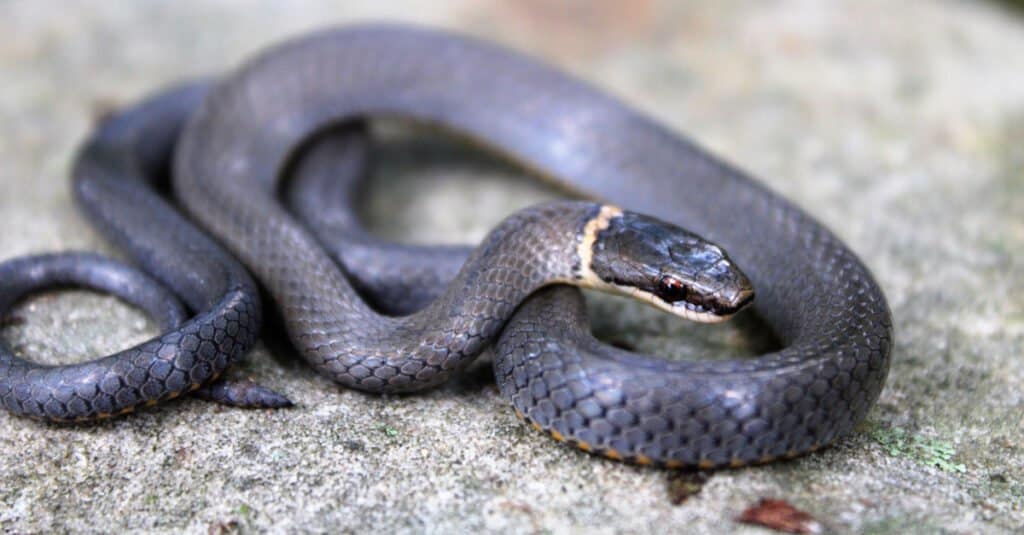
Ring-necked snakes are easy to identify thanks to the ring on their neck.
©Tucker Heptinstall/Shutterstock.com
You can identify a ring-necked snake by size and by the light-colored ring around the neck. The light yellow ring around the snake’s gray body is very distinctive and had to miss. Ring-necked snakes are very small and rarely grow past 15 inches. These snakes prefer dark and damp places so you will usually run into them under logs or rocks or near the roots of trees in the forest. They don’t go into the Bluegrass region of the state. However, they often hide along the Kentucky River and in the mountains.
Water Snakes in Kentucky
There are five species of true water snakes in Kentucky. They are:
- Broad-Banded Water Snake
- Copperbelly Water Snake (Plainbelly Water Snake subspecies)
- Diamondback Water Snake
- Mississippi Green Water Snake
- Northern Water Snake.
Four of these species are only found in Western Kentucky, mostly near where the Mississippi and Ohio rivers converge.
The Mississippi green water snake is found only in counties like Bullard, Carlisle, Hickman, and Fulton that are adjacent to the Mississippi River. Copperbelly water snakes are found in a limited region in Western Kentucky along the Ohio River. Diamondback water snakes can grow past five feet long and have a larger range that includes the Land Between the Lakes National Recreation Area. Finally, the Broad-banded water snake is only found close to the Mississippi River in Kentucky. None of these water snakes are venomous.
The most common water snake, with a range that extends across the state, is the northern water snake, which we’ll look at in more detail.
Northern Water Snake

©jmarino/Shutterstock.com
The northern water snake is a snake that can be found throughout Kentucky near rivers and streams. Quite often people mistake the northern water snake for the copperhead or cottonmouth snake, but unlike the copperhead or cottonmouth, the northern water snake isn’t venomous. Even though these snakes can grow to an intimidating 60 inches in length they are harmless. They are attracted to light so if you’re fishing at night or early in the morning you may attract them.
Venomous Snakes in Kentucky
There are only four venomous snakes in Kentucky but as with any venomous snake, you should always be cautious when you encounter them! The venomous snakes in Kentucky to watch out for are:
Copperhead
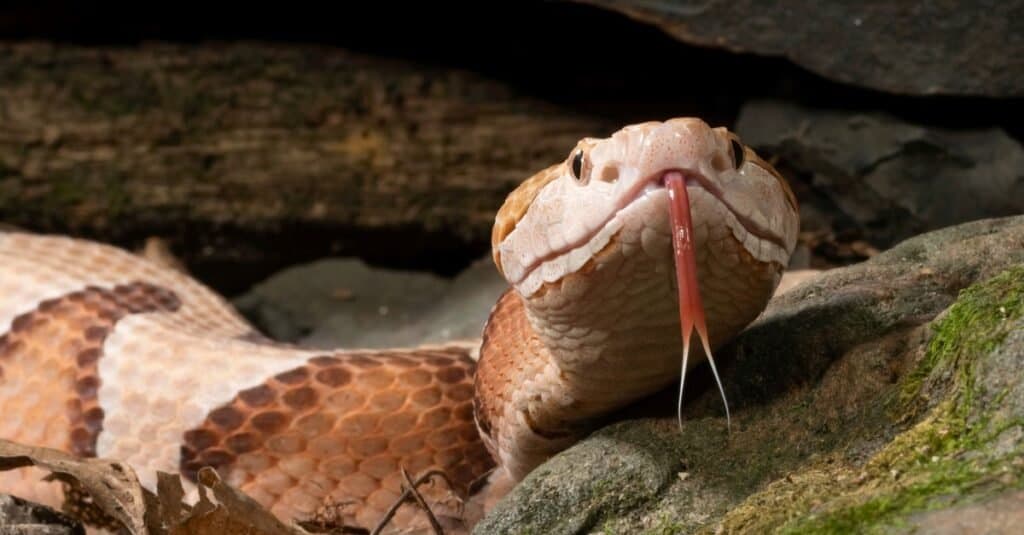
Copperhead snakes live in marshes, rocky areas, and forests in Kentucky.
©Joe McDonald/Shutterstock.com
Copperhead snakes prefer lowland marches, rocky areas, and forests but it’s important to know that during the fall and spring they are active all day and not just at night. During the heat of the summer they generally only are active at night. Copperhead snakes have a distinctive red brown color on their heads and hourglass markings in dark brown on their bodies. Even though the copperhead snake looks scary and it is venomous, the venom it has isn’t as deadly as the venom that some other types of snakes have. Still, it’s best to avoid any confrontations with a copperhead!
Timber Rattlesnake
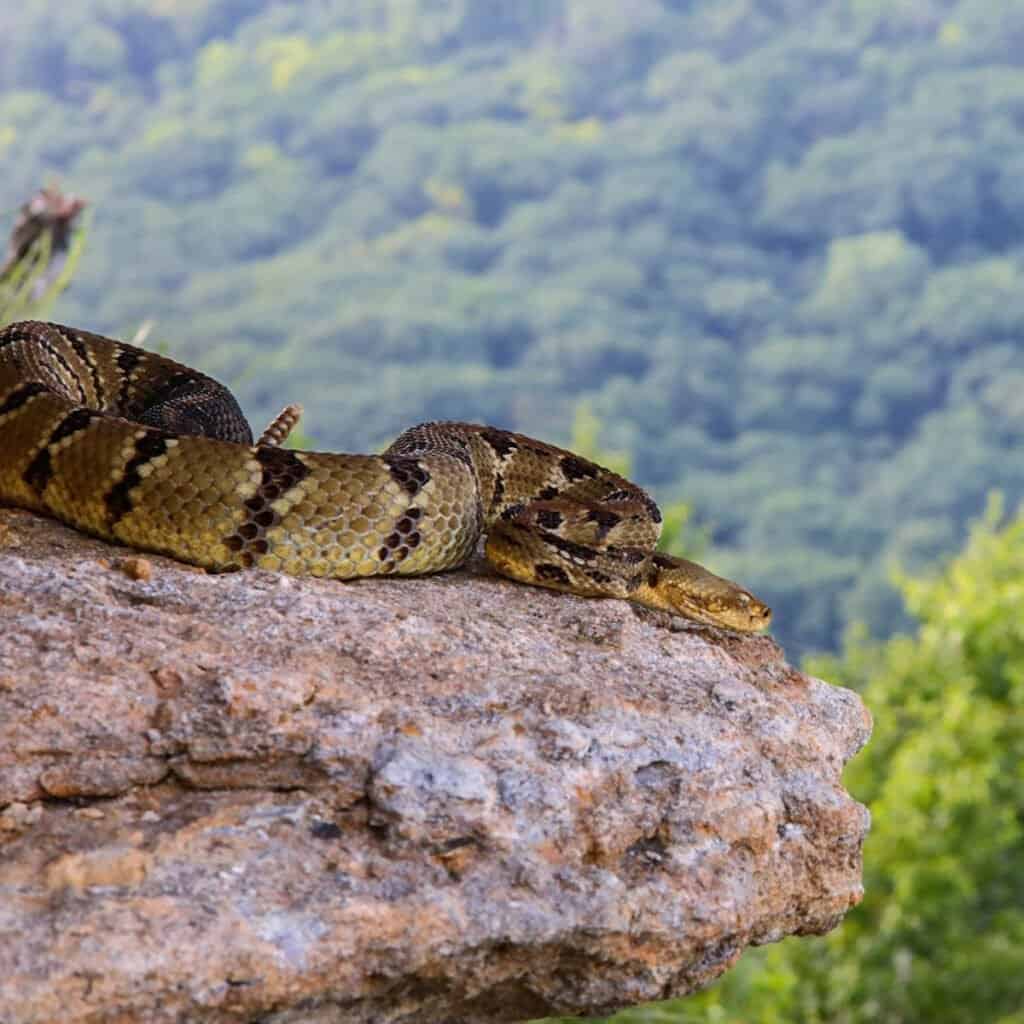
Timber rattlesnakes are the most venomous snake in Kentucky.
©bradenjalexander/Shutterstock.com
The timber rattlesnake is a snake to avoid at all costs. Timber snakes prefer to stay in dense forests and rocky mountain outcroppings so unless you are hiking or hunting you probably won’t run into one. Timber rattlesnakes hibernate in the winter and are only active from the spring through the fall. Once the weather gets cold they will find a den and hibernate (brumate) until the spring. These snakes can grow up to a whopping 60 inches long and they have the deadliest venom of any snake in Kentucky. You can recognize a timber rattlesnake by its large size, the black rattle on the end of the tail, and its triangular head. Their body has a unique dark crossband pattern that is another characteristic you can use to identify it.
Northern Cottonmouth
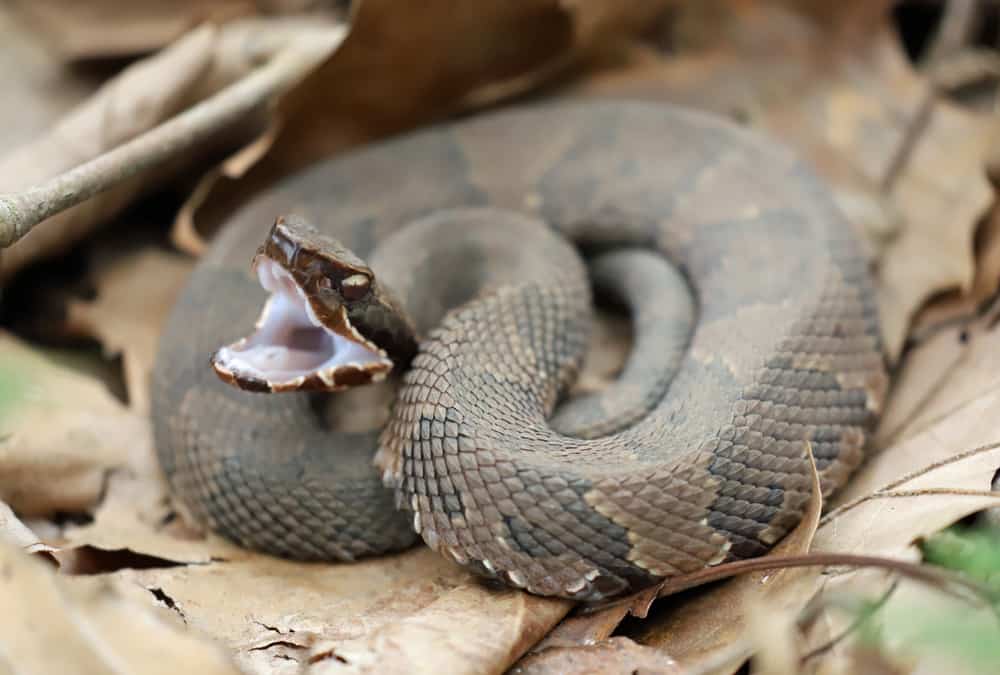
Cottonmouths are typically found in aquatic environments.
©KF2017/Shutterstock.com
Northern cottonmouth snakes like to be near or in the water, so if you like to fish or swim in lakes and streams this is the snake to watch out for. These snakes are venomous. Cottonmouths are primarily nocturnal, so if you’re fishing early in the morning there may still be some snakes active. They hibernate throughout the winter and are only active during the spring, summer, and fall seasons. You can identify a cottonmouth snake by the large white mouth. That’s why it’s called a cottonmouth! It has a very large mouth that is white like cotton. If a cottonmouth feels threatened it will open that giant mouth as a warning. The cottonmouth’s bite can be very painful and dangerous so always be extremely cautious around this snake.
Western Pygmy Rattlesnake
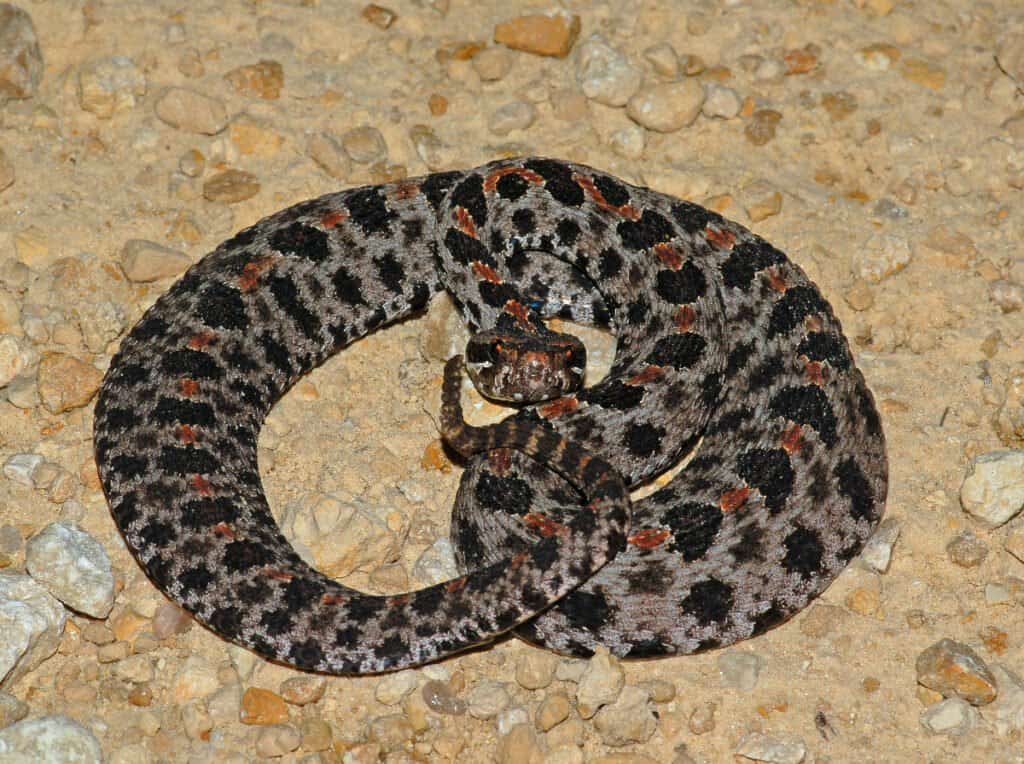
Western pygmy rattlesnakes only grow up to a couple feet in length.
©Gerald A. DeBoer/Shutterstock.com
Western pygmy rattlesnakes are fairly rare in Kentucky so your chances of running into one are relatively low. But this snake does prefer to live in sandhills and near water so if you’re fishing, swimming, or hiking there is a chance you will run across one. As you may have guessed by the name these snakes are quite small and usually are just 16-24 inches long. They have a fierce rattle and they are venomous but their venom isn’t deadly. A western pygmy bite hurts and can cause a lot of damage so get medical care right away if you are bitten.
Black Snakes in Kentucky
Generally, the term “black snake” describes the black rat snake, also known as the western rat snake, black rat snake, and pilot black snake. The black rat snake is capable of adapting to different habitats in Kentucky and is most often found in forests and plains.
These black snakes are nonvenomous and use constriction to kill their prey. As they lack venom, they use the defense mechanism of releasing a foul musk as well as shaking their tails in a way similar to rattlesnakes to scare off potential predators. They grow to 4-6 feet long, although they can be larger as the biggest recorded was 8 feet!
Other species of snakes that are primarily colored black and found in Kentucky include: Eastern black kingsnake, astern hog-nosed snake, north American black racer, red-bellied mudsnake, and ring-necked snake. Read more about them here.

The black rat snake is one of the black snakes that lives in Kentucky.
©iStock.com/RCKeller
Snake Safety in Kentucky
While there are some species of snakes in Kentucky that inhabit urban and suburban areas most of the snakes in Kentucky prefer wild areas for their habitats. If you’re an avid outdoor enthusiast and love to fish, hike, or hunt make sure that you are always aware of your surroundings and check areas carefully for any snakes.
Summary of Common Snakes Found in Kentucky
Here’s a recap of the snakes commonly found in the state of Kentucky that we took a close look at:
| Number | Snake | Type |
|---|---|---|
| 1 | Eastern Garter Snake | Nonvenomous |
| 2 | Gray Rat Snake | Nonvenomous |
| 3 | Ring-Necked Snake | Mildly venomous |
| 4 | Northern Water Snake | Nonvenomous |
| 5 | Copperhead | Venomous |
| 6 | Timber Rattlesnake | Venomous |
| 7 | Northern Cottonmouth | Venomous |
| 8 | Western Pygmy Rattlesnake | Venomous |
| 9 | Black Rat Snake | Nonvenomous |
A Complete List of Snakes in Kentucky
The 34 types of snakes that can be found in Kentucky are:
- King snake (Eastern black)
- Black Racer
- Gray Rat Snake
- Broad-Banded Water Snake
- Brown Snake
- Coachwhip Snake
- Copperbelly Water Snake
- Corn Snake
- Diamondback Water Snake
- Eastern Garter Snake
- Eastern Hognose Snake
- Ribbon Snake
- Kirtland’s Snake
- Milk Snake
- Mississippi Green Water Snake
- Mud Snake (Red-bellied Mud Snake)
- Pine Snake
- Northern Redbelly Snake
- Northern Water Snake
- Prairie King snake
- Plaine-bellied Water Snake
- Queen Snake
- Red-Bellied Snake
- Ringneck Snake
- Rough Green Snake
- Scarlet King snake
- Scarlet Snake
- Smooth Earth Snake
- Southeastern Crowned Snake
- Timber Rattlesnake
- Western Cottonmouth
- Western Mud Snake
- Western Ribbon Snake
- Worm Snake.
Other Reptiles Found in Kentucky
Kentucky is currently home to 56 reptile species, including 10 lizards, 32 snakes, and 14 turtles. Notably, the Eastern Coachwhip snake has not been observed in Kentucky for over four decades and may not have originally been native to the state.
While the majority of these reptiles are native, Kentucky also hosts two exotic species, the Common Wall-lizard and the Mediterranean House Gecko.
Here are other species of reptiles found in Kentucky:
- Smooth Softshell Turtle
- Spiny Softshell Turtle
- Common Snapping Turtle
- Alligator Snapping Turtle
- Eastern Mud Turtle
- Common Musk Turtle
- Southern/Midland Painted Turtle
- Common Map Turtle
- Ouachita Map Turtle
- Mississippi Map Turtle
- False Map Turtle
- Eastern River Cooter
- Red-eared Slider
- Eastern Box Turtle
- Coal Skink
- Five-lined Skink
- Broadhead Skink
The photo featured at the top of this post is © iStock.com/Mark Kostich
Discover the "Monster" Snake 5X Bigger than an Anaconda
Every day A-Z Animals sends out some of the most incredible facts in the world from our free newsletter. Want to discover the 10 most beautiful snakes in the world, a "snake island" where you're never more than 3 feet from danger, or a "monster" snake 5X larger than an anaconda? Then sign up right now and you'll start receiving our daily newsletter absolutely free.
Thank you for reading! Have some feedback for us? Contact the AZ Animals editorial team.






